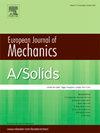Modeling and vibration characteristics analysis of flexible spiral bevel gear system
IF 4.2
2区 工程技术
Q1 MECHANICS
引用次数: 0
Abstract
This paper proposes a novel modeling approach for the spiral bevel gear system that incorporates the flexibility of both gears and thin-walled hollow shafts. Shell elements are employed to model the gear and shaft structures. To more accurately represent the interaction between components, a flexible connection is introduced to replace the conventional rigid beam coupling between bearing and shell elements. The gear meshing process is simulated using distributed springs rather than a single equivalent spring, and the component mode synthesis (CMS) method is applied to enhance computational efficiency. The proposed model is validated by comparing its modal and dynamic responses with those obtained from a finite element model (FEM). Using this model, the effects of interfacial coupling methods, meshing methods, gear flexibility, and rotational effects on the system's dynamic behavior are systematically analyzed. The results demonstrate that, for large diameter-to-thickness ratios, the traditional rigid coupling method introduces significant deviations in modal analysis and resonance prediction. Conventional meshing simulation methods exhibit limitations in accurately predicting critical rotational speeds. The conventional model neglects the flexibility of the gear and the radial deformation of the hollow shaft, resulting in substantial errors in resonance prediction compared to the proposed model. These findings highlight the necessity of incorporating gear and shaft flexibility. Moreover, the gyroscopic effect (GE) is identified as the dominant contributor among rotational influences and warrants particular attention.
柔性螺旋锥齿轮系统建模及振动特性分析
本文提出了一种新的螺旋锥齿轮系统建模方法,该方法同时考虑了齿轮和薄壁空心轴的柔性。采用壳单元对齿轮和轴结构进行建模。为了更准确地表示部件之间的相互作用,引入了柔性连接来取代轴承和壳体单元之间传统的刚性梁耦合。采用分布式弹簧代替单一等效弹簧对齿轮啮合过程进行仿真,并采用组件模态综合(CMS)方法提高计算效率。通过与有限元模型的模态响应和动力响应进行比较,验证了该模型的有效性。利用该模型,系统地分析了界面耦合方式、啮合方式、齿轮柔度和转动效应对系统动力学行为的影响。结果表明,对于大径厚比,传统的刚性耦合方法在模态分析和共振预测中存在较大偏差。传统的网格模拟方法在准确预测临界转速方面存在局限性。传统的模型忽略了齿轮的灵活性和空心轴的径向变形,导致共振预测与该模型相比有很大的误差。这些发现突出了结合齿轮和轴的灵活性的必要性。此外,陀螺效应(GE)被确定为旋转影响中的主要因素,值得特别注意。
本文章由计算机程序翻译,如有差异,请以英文原文为准。
求助全文
约1分钟内获得全文
求助全文
来源期刊
CiteScore
7.00
自引率
7.30%
发文量
275
审稿时长
48 days
期刊介绍:
The European Journal of Mechanics endash; A/Solids continues to publish articles in English in all areas of Solid Mechanics from the physical and mathematical basis to materials engineering, technological applications and methods of modern computational mechanics, both pure and applied research.

 求助内容:
求助内容: 应助结果提醒方式:
应助结果提醒方式:


